|
|
 |
Canadian Historic Sites: Occasional Papers in Archaeology and History No. 20
The History of Fort Langley, 1827-96
by Mary K. Cullen
Gold Rush: Climax and Turning Point of Fort Langley's Career
The endurance of the commercial prominence which Fort Langley
achieved as a trading and transporting point in the 1850s was predicated
on many factors, but on none more fundamental than the continuance of
the fur trade. As long as the vast territory of the Pacific mainland was
essentially an isolated preserve of the Hudson's Bay Company with a
total non-Indian population of less than 200, fur resources and the
logistics of supply determined the important foci of activity. When the
Fraser River gold rush rapidly altered the number and distribution of
people and centres, the fur trade collapsed and the economic life of
Fort Langley was profoundly changed. During the months of 1858 which
brought about this change, Langley climaxed its career by becoming the
starting point for the gold rush and the inauguration place of a British
colony on the Pacific mainland.
Discovery of gold on the Flathead River in Oregon prompted Company
discussion on the impact of a major northern discovery almost three
years before the famous Fraser River rush. In August 1855 Douglas
predicted that "the streams north of the Columbia will be found equally
rich in gold, and probably the day is not distant when the great
discovery will be made."1 Then and later there was
apprehension that the fur trade would suffer from the effects of these
discoveries, but a more persistent concern was that the Company, by
supplying the miners, might increase the value of its general
returns.2 In March 1856 Douglas wrote to Simpson, "the
chances of our making a profitable trade will be greater just in
proportion as the expense of transport decreases, and the locality of
the Gold diggings is brought nearer our Depot at Fort
Langley."3
During the spring of 1856, gold was found in several parts of the
Thompson River District and Yale reported small quantities of the metal
in the bed of the Coquihalla River near Fort Hope.4 New
discoveries made by native peoples throughout the following year
provided assurance of gold being found in considerable quantities in the
British interior.5 The Company post at Kamloops traded 49
ounces of gold dust from Indian diggers in August 1857.6 Both
Indians and fur traders moved to monopolize the gold deposits for their
own benefit, the Indians by open antipathy to foreign
adventurers,7 the Company by legal and practical measures to
cut off American competition for the gold trade.
The Hudson's Bay Company had no legal governing authority on the
Pacific mainland, but for years its board of management had skillfully
acted to protect life and property and to contain crises between the
native people and the whites. Douglas now attempted to protect the
Company from American entrepreneurs in the same paternalistic fashion.
In November he wrote the officer at Kamloops that "the Company having
the exclusive right of trading with Indians on the West side of the
mountains, no other person can lawfully carry on trade or erect trading
establishments within the British territory and you may warn them off on
any attempt to do so."8 As governor of Vancouver Island and
nearest British official within thousands of miles, Douglas also issued
a proclamation declaring the rights of the crown to all gold found in
its natural place of deposit and forbidding gold seekers unless duly
authorized by Her Majesty's colonial government.9
The practical step of preparing and operating supply routes to the
mines put the Hudson's Bay Company in the best position to dominate
future events. For this important task Douglas enlisted the trailblazing
aptitude and depot experience of Fort Langley. Yale advised that goods
might be forwarded by way of the 13-mile Douglas Portage as far as the
junction of the Thompson and Fraser.10 A plan was therefore
devised to have a transport corps of two officers, ten white men and
several Indians to conduct a continuous supply service by this
route.11 The machinery for the transport operation involved
two lines of river craft: canoes for use between the Thompson and the
upper end of the rapids of the Fraser River and batteaux for 130 miles
from the lower end of the rapids to Langley.12 The journey
through Douglas Portage was to be made on foot. Langley carpenters built
the batteaux in January and the transport service commenced a month
later.13
Two trips were made by the Fraser before the annual rise in the river
forced the transfer of supply services to the Fort Hope road. Douglas
was at Fort Langley on 15 February to dispatch the first supply party
for the interior. The expedition, in clerk George Simpson's charge, took
one loaded batteaux as far as old Fort Yale, transported the property
overland by Douglas Portage to Spuzzum immediately above the falls, and
thence went by canoe to Tecungean (now Lytton) where the Thompson met
the Fraser. There the goods were received by a horse brigade from
Kamloops.14 On a second inland trip in March, an enlarged
Fort Langley party started building a new post at the forks, to be
called Fort Dallas (in November that year its name was changed to
Lytton)15 The old buildings at Fort Yale, which had been
abandoned after Peers's road to Fort Hope became the brigade trail, were
renewed and a stack of provisions were laid up there and at Fort Dallas
for the spring trade.16
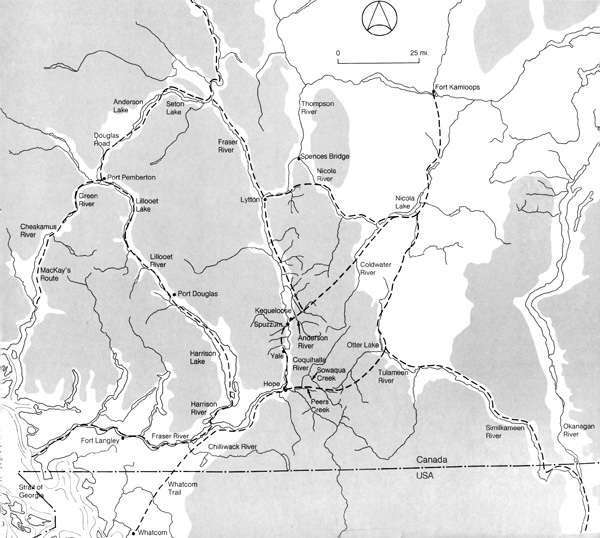
16 Brigade routes to the Fraser River gold fields. Gray indicates major
mountainous areas. (click on image for a PDF version)
(Map by K. Gillies)
|
Throughout these preparations the Company monitored the extent of
possible gold deposits. Since the Indian population had commenced mining
on the Thompson in July, there had been a total gold yield of 1,000
ounces. Allowing for the disproportion in the number and skill of the
mining population in the two countries, the return was relatively small
compared to the California mines which during the same initial
eight-month period yielded 150,000 ounces.17 The conclusion
seemed obvious: these statistics would not attract the white miner, but
when news spread that 800 ounces of gold had been sent from Victoria to
the San Francisco mint in February,18 the rush to Fraser
River was on.
The great influx of adventurers started in April when the American
steamer Commodore arrived in Victoria with 455 passengers from
San Franciso. There were double that number in May, more than 7,000 in
June, 7,000 in July and at least 8,000 more who made their way overland.
By August when the fever began to subside, the registered departures
from San Francisco had totalled almost 30,000. Frequently, ships carried
more than the officially accepted number. The Sierra Nevada,
which landed 1,900 people in Victoria on 1 July, had sailed from San
Francisco the previous month with a "maximum" of 900
passengers.19
Since the first focus of mining activity was at the junction of the
Thompson and Fraser rivers, whether would-be prospectors came overland
or by boat from Victoria, Fort Langley was for all the last point before
the gold district. As such the fort became the administrative and
policing centre of British and Company interests. On 8 May 1858 Douglas
issued a proclamation asserting the exclusive trading rights of the
Hudson's Bay Company, forbidding British and foreign trade on the
mainland and requiring all river craft of any sort to purchase a licence
from the Company and a sufferance from the proper customs officer at
Victoria.20 To enforce these regulations Douglas persuaded
the naval authorities to station the gunboat Satellite at the
mouth of the Fraser and to anchor her launch and gig off Langley. Two
revenue officers at Langley seized contraband goods and took unlicensed
canoes into custody.21
In addition to its policing responsibilities, Langley had already
assumed charge of the forwarding business to the mines and now became
itself a major retail outlet. The Fort Langley saleshop was doing a
brisk business in May and had received 336 ounces of gold dust and about
$5,000 cash since the beginning of March.22 Articles in
demand were blankets and woollen clothing, tinware such as pots and
frying pans, various mining tools including pans and pickaxes, and
provisions, principally flour, bacon, beans and molasses. Food was
scarce but the Company tried to keep it inexpensive. Flour sold at nine
dollars per 100-pound sack and sugar at 16 cents a pound. In
anticipation of greater scarcity of food in the winter of 1858-59, the
Company directed its traders to secure as many dried salmon as
possible.23
To the average miner, American in extraction and used to the
undisciplined free enterprise of California mining towns, dealing at the
Hudson's Bay Company fort store was an unusual experience. The editor of
the Alta California recorded in detail his observations of the
regimentation of business at Langley saleshop.
At six o'clock in the morning the massive bolts and bars are
unlocked from the entrances to the stockade which surrounds the
buildings of the Hudson's Bay Company .... At a later hour in the
morning the door of the sales-room is opened, in the loft next to the
northeastward of the chief trader's residence, and the business of the
day begins. The door is scarcely opened when the small space allotted to
customers inside the building is filed with people, and from that moment
trade is unceasing, and a continuous stream of coin flows into the till
of the Company until noon, when a bell rings and business ceases at
once. Everybody leaves the store-house, the doors are closed, and all
hands go to dinner. At the end of an hour business is resumed again, and
the same dull and monotonous routine is gone through with until six p.m.
when again trade is brought to a dead halt, the crowd disperses, and the
business portion of the day is ended.
The conduct of business was not only routine, but also quaint and out
of fashion. Amused, the writer continued,
Inside this trading warehouse there is a look of venerable
antiquity that it would be difficult to match in any other portion of
the world today. The scales used for weighing out the wet goods are the
old style balances, with ponderous upright and beam, and capacious trays
for the reception of merchandise, suspended from the one end, and one
for the weights from the other. Everything else about the establishment
is in keeping with this, and business is transacted exactly as it used
to be in the quaint old towns of the thriving Knickerbockers and early
tradespeople of staid New England.
A bottle of whiskey, or "Hudson's Bay lightning," as it is not
inappropriately called, when sold to a purchaser, is first carefully
corked, then a string tied around the neck, and a loop formed so that it
may be conveniently suspended from the finger, then a piece of paper is
carefully wrapped around it, and the customer receives possession of his
property ... it is to such customs that Young America applies the
expressive title of "old fogyism."24
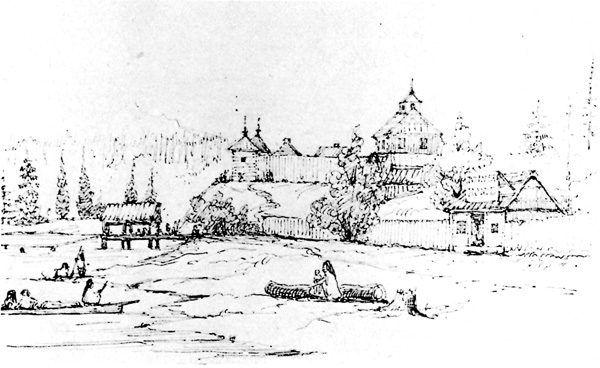
17 Fort Langley, 24 May 1858, from the private sketchbook of Alexander
Grant Dallas.
(Dr. O.V. Briscoe, London, England.)
|
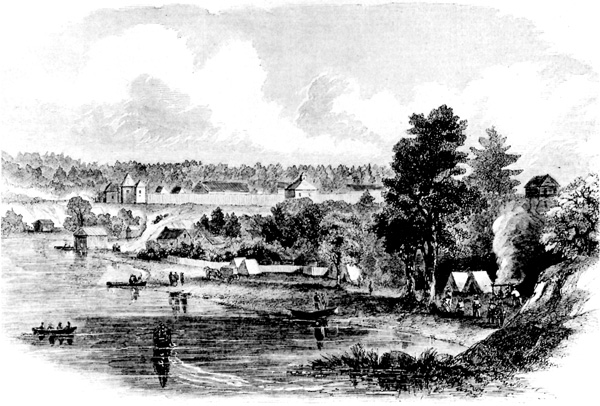
18 "Fort Langley, Frazer's River," Harper's wWeekly, 9 October
1858.
(U.S. National Archives, Washington, D.C.)
|
In April the Company concluded the loft saleshop was too small and
inconvenient for a large-scale business and decided to relocate the
retail operation on the ground floor of the residence to the left of the
Big House. The new shop, fitted up during May, was divided into a store
area and a baling room for packing servants' orders and other
purposes.25 But the salesroom was never used,26
probably because the extension of navigation to Forts Hope and Yale
diverted much of the expected business from Langley.
Hudson's Bay Company vessels (principally the Otter), which by
law provided the only steamship accommodation on the Fraser, were too
heavy to ascend the river beyond Fort Langley. To reduce the expense of
batteaux transport the Company contemplated buying a small river steamer
of 100 tons to ply between Fort Langley and the rapids on the Fraser
River.27 The purchase was not made, however, before the need
was met through an other avenue. In June the Hudson's Bay Company agreed
to license steamers to run between Victoria and the rapids on certain
conditions, among them the carriage of only Company goods and the
payment of two-dollar fee to the Company for every
passenger.28 On Sunday 7 June the American steamer
Surprise made the first steam trip to Fort Hope and a month later
the stern-wheeler Umatilla reached Yale.29 Although
Fort Langley now shared a greater amount of business with the up-river
posts, for two months it continued to be the hub of commercial activity
on the Fraser. During June and July the influx of adventurers reached
its peak with 1,732 persons arriving in a single day in
July.30 Not all of these could afford passage on the river
steamers and they paddled their own craft to the Fraser, calling first
at Fort Langley. Visiting the site in July, Douglas reported sales
averaging $1,500 a day.31 A small tent village was growing
outside the palisade and one enterprising individual opened a log cabin
called the "Miner's Home," offering fare that "would have done no
discredit to a first-class restaurant."32
The arrival of the brigade train on 30 June was a festive occasion
for both Company men and miners at Langley. A Prince Edward Island
prospector, who attended the welcoming ball for the annual visitors,
wrote his impressions of the event for the people back home.
I ... was not a little surprised at seeing the company composed of so
heterogeneous a kind. There were the English, Scotch, French and
Kanackas present, and their offspring, and all so thoroughly mixed with
the native Indian blood, that it would take a well versed Zoologist to
decide what class of people they were, and what relations they had to
each other; though that will cause you but little surprise, when you are
informed that almost all the Co.'s wives are the native Squaws, their
children, which are called half breeds, as a general thing, being quite
fair, docile and intelligent. The Ball was conducted with the best
possible decorum. The music was sweet, from the violin, and the dancing
was performed in the most gracefull manner, by the Indians and the half
breeds, who took a very prominent part on that
occasion.33
Gold fever created a state of intense excitement among the men of the
brigade contingent that summer. Many of them had no doubt personally
talked with miners at Lytton, Fort Hope and Langley. They were not
disposed to continue in the service at £20 a year for middlemen
and £25 a year for "Boates" while others made as much in one week
digging gold. Only after ardent persuasion by Douglas did they agree to
be rehired at an advance of £10 each on their former rate of
pay.34 On 18 July the brigades from Thompson River and New
Caledonia left Fort Langley for the last time. The opening of steam
transportation 80 miles beyond Fort Langley had created a new head of
navigation and meant that henceforth the depot for the Company brigades
would be Fort Hope.35
Inevitably the gold rush caused greater disruption and change in the
fur trade. The sudden influx of thousands of foreigners into a large
unorganized territory immediately raised problems of law, order and
nationality. In his efforts to preserve discipline over the mining
community, Douglas made little distinction between Company and British
interests. Payment of suffrances and the observance of other Company
rules might also be interpreted as a recognition of the authority of the
crown from which the Company received its rights. Revenue officials and
officers of the warship Satellite equally enforced British
customs laws and the Company monopoly. Douglas, governor of Vancouver
Island and chief manager of the Hudson's Bay Company on the Pacific
Coast, personally epitomized the identity of crown and
company,36 but it was an identity that could never endure.
Douglas early realized that government by proclamation was an inadequate
means of permanently administering a new population. Implicit in his
resolve to secure maximum benefit for the Company from the rush was a
fatalistic attitude toward the survival of the fur trade. Company
experience in Oregon had proved the incompatibility of the fur trade and
large-scale immigration. By June Douglas was convinced that the growth
in the number of squatters throughout the Fraser valley was "impossible
to arrest" and he therefore recommended the immediate opening of the
country for settlement with due compensation to the Hudson's Bay Company
for relinquishing its licence.37
The imperial government discussed the problem of governing the
mainland during the summer of 1858. There was strong approval of
Douglas's effort to maintain public order and the rights of the crown
but condemnation of his liberal interpretation of Company rights. In a
dispatch dated 16 July 1858, Colonial Secretary E.B. Lytton reminded
Douglas that "the Company is entitled under its existing license, to the
exclusive trade with the Indians and possesses no other right or
privilege whatever." He pointed out that it was therefore contrary to
law and consequently disallowed to exclude importation of goods or to
prevent any persons from trading with any inhabitants except the Indians
— still more to require a licence from the Company for persons
landing in the territory.38 At the same time Douglas was
authorized to take such measures consistent with the rights of British
subjects.39 Her Majesty's government decided to establish a
mainland colony and proposed that Douglas be appointed governor on
condition that he sever all connections with the
Company.40
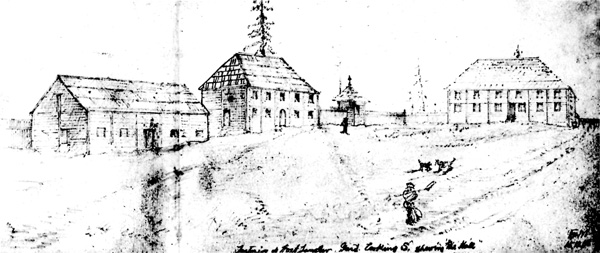
19 The interior of the Fort Langley yard, looking south, showing
"the Hall," by E. Malladaine, 15 December 1858.
(Provincial Archives of British Columbia.)
|
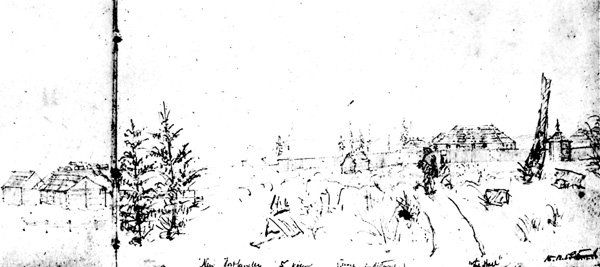
20 Fort Langley, south view, by E. Malladaine, 15 December 1858.
(Provincial Archives of British Columbia.)
|
The Act creating the colony of British Columbia was passed by the
British Parliament on 2 August 1858.41 Douglas was appointed
governor on 2 September42 and by an instrument of the same
date the exclusive trading privileges of the Hudson's Bay Company were
abrogated.43 A detachment of 150 Royal Engineers under the
command of Colonel Richard Moody was immediately dispatched to the coast
to survey land for public sale, lay out the capital, construct roads and
assist in the various duties of colony building.44 The first
two parties, commanded by Captains Parsons and Grant, arrived in
Victoria on 29 October and 8 November respectively.45
Following the arrival of incumbent chief justice Matthew Baillie
Begbie on 15 November,46 a ceremony took place for the
administration of oaths and the formal proclamation of the new
colony.
The official inauguration of the colony of British Columbia took
place at Fort Langley on Friday, 19 November 1858. Although steady rain
throughout the day threatened to mar the event, the ceremony was
conducted with becoming solemnity inside the Big House. An account of
the proceeding appeared in the Victoria Gazette of 25 November.
His Excellency, accompanied by ... a guard of honor commended by
Capt. Grant disembarked on the wet, loamy bank under the Fort, and the
procession proceeded up the steep bank which leads to the palisade.
Arrived there, a salute of 18 guns commenced pealing from the Beaver,
awakening all the echoes of the opposite mountains. In another moment
the flag of Britain was floating, or, to speak the truth, dripping over
the principal entrance. Owing to the unpropitious state of the weather,
the meeting which was intended to have been held in the open air was
convened in the large room at the principal building. About 100 persons
were present.
The ceremonies were commenced by His Excellency addressing Mr.
Begbie, and delivering to him Her Majesty's commission as Judge in the
Colony of British Columbia. Mr. Begbie then took the oath of allegiance,
and the usual oaths on taking office, and then, addressing His
Excellency, took up Her Majesty's Commission appointing the Governor,
and proceeded to read it at length. Mr. Begbie then administered to
Governor Douglas the usual oaths of office, viz.: allegiance,
abjuration, etc. His Excellency being then duly appointed and sworn in,
proceeded to issue the Proclamation of the same date, (19th instant)
viz.: one proclaiming the Act; a second, indemnifying all the officers
of the Government from any irregularities which may have been committed
in the interval before the proclamation of the Act; and a third
proclaiming English Law to be the Law of the Colony. The reading of
these was preceded by His Excellency's Proclamation of the 3d inst.,
setting forth the Revocation by Her Majesty of all the exclusive
privileges of the Hudson Bay Company.
The proceedings then terminated. On leaving the Fort, which His
Excellency did not finally do until today [20 November] another salute
of 17 guns was fired from the battlements, with even a grander effect
than the salute of the previous day.47
As the echoes of the 17-gun salute faded into the mountains, the
impact of the new order was beginning to show in a slowdown of
activities at the fort. Langley, head of transportation and forwarding
centre for the interior, was now superseded by Forts Hope and Yale on
the Fraser and by Port Douglas, the terminus of the navigable portion
of the busy new Harrison-Lillooet route.48 A.G. Dallas, who
replaced Douglas as head of the Company's board of management for the
West Coast, announced in March 1859 that goods would henceforth be
shipped direct to Forts Hope and Yale.49 As a result, most of
the work associated with being brigade depot was abandoned at Langley,
specifically boat building, packing, loading and transportation of
interior outfits, fur baling and shipping, and the lodging, provisioning
and equipping of the brigade contingent. Fewer travellers called at the
fort and business at the saleshop became exceedingly
dull.50
Early in 1859 speculation increased that the site of the original
Fort Langley built by McMillan in 1827 would become the capital of the
new colony. A townsite had been laid out and a public auction of lots
held in Victoria on 25 November 1858 reserved "the best situated lots
... for the special purposes of government."51 But the
favourable combination of shipping, farm and fishery facilities which
had made the south side of the Fraser so vital to the fur trade was not
the criterion used for the final selection of the new capital. Imperial
military strategy ruled out Langley as too vulnerable in the event of an
American attack.52 In February 1859 Colonel Moody designated
a site on the north bank of the river as official port of entry and
capital of British Columbia.53 This decision encouraged the
development of New Westminster54 as the principal commercial
town on the mainland in preference to Fort Langley, the traditional
commercial centre on the Fraser.
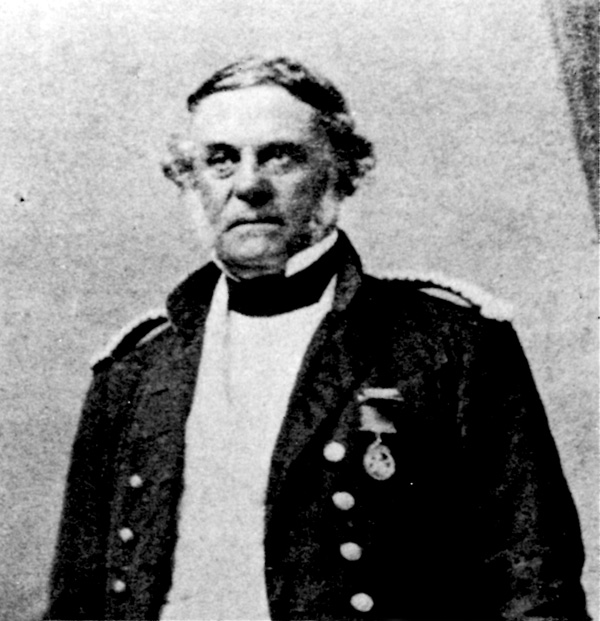
21 James Douglas, governor of the colony of British Columbia, 1858-63.
(Provincial Archives of British Columbia.)
|
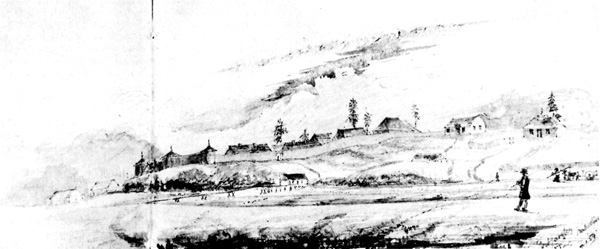
22 Fort Langley, north view, from the Fraser River, by E. Malladaine, 7
January 1859.
(Provincial Archives of British Columbia.)
|
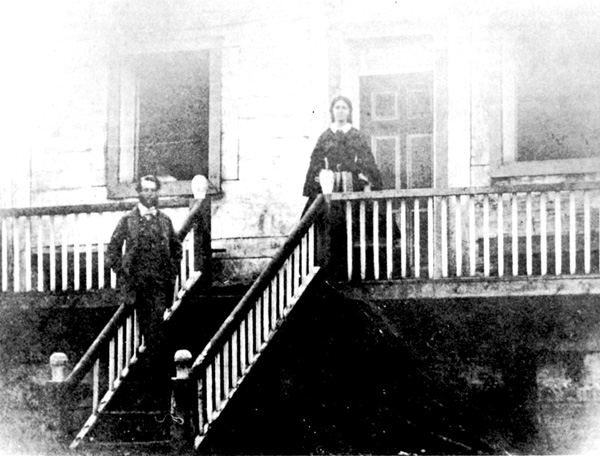
23 William Henry Newton and his wife at the Fort Langley Big House.
Newton was clerk in charge of Langley in 1859-60, 1860-64 and 1874-75.
(Provincial Archives of British Columbia.)
|
|

